

Compact Muon Solenoid
LHC, CERN
| CMS-PAS-HIN-24-005 | ||
| Jet fragmentation function and groomed substructure of bottom quark jets in proton-proton collisions at 5.02 TeV | ||
| CMS Collaboration | ||
| 6 September 2024 | ||
| Abstract: A measurement of the substructure of bottom quark jets (b jets) in proton-proton (pp) collisions is presented. The measurement uses 301 pb−1 of data collected in pp collisions by the CMS experiment at √s= 5.02 TeV. An algorithm to identify and cluster the decay charged-particle daughters of b hadrons is developed for this analysis, which facilitates the exposure of the gluon-radiation pattern of b jets using iterative Cambridge-Aachen clustering. The soft drop groomed jet radius Rg and the groomed momentum balance zg of b quark jets are presented. The zg and Rg observables can be used to test perturbative quantum chromodynamics predictions based on the Dokshitzer-Gribov-Lipatov-Altarelli-Parisi parton splitting functions that account for mass effects. Because the b hadron is partially reconstructed using charged particles, only charged particles are used for the jet substructure. In addition, a jet fragmentation function is measured, which is the ratio of the transverse momentum pT of the partially reconstructed b hadron with respect to the charged component of the jet pT. The substructure distributions are unfolded to the charged-particle level. The b jet substructure is compared to the substructure of jets in an inclusive jet sample that is dominated by light quark and gluon jets, in order to assess the role of the b quark mass. A strong suppression of emissions at small Rg values is observed for b jets when compared to inclusive jets, consistent with the dead cone effect. The measurement is also compared with theoretical predictions from Monte Carlo event generators. This is the first substructure measurement of b jets that clusters the b hadron decay daughters. | ||
| Links: CDS record (PDF) ; CADI line (restricted) ; | ||
| Figures | |

png pdf |
Figure 1:
Left: schematic diagram of two Cambridge−Aachen subjets, such as those found with the soft drop grooming algorithm. The splitting angle ΔR1,2 and the relative transverse momentum kT between the two subjets are annotated. Right: Lund jet plane regions of bottom quark jets. The vertical axis is the logarithm of the relative transverse momentum kT of the softer subjet with respect to the harder subjet. The horizontal axis is the logarithm of the opening angle between the softer and harder subjets, ΔR1,2. The Lund jet plane is expected to be dominated by hadronization effects for kT below the GeV scale. Above the GeV scale, the Lund jet plane provides information on the parton showering description. Emissions are suppressed at small angles due to the dead cone effect, depicted in blue. The b hadron decays (not depicted) populate the same region. The shading represents the density of emissions in the primary Lund jet plane for b quark jets. |

png pdf |
Figure 2:
The Lund jet plane of the soft drop emissions of b quark jets at the particle level simulation (PYTHIA8 CP5). The vertical axis is the logarithm of the kT of the emission, whereas the horizontal axis is the logarithm of R/Rg, such that large-angle emissions populate the left-hand side of the diagrams and small-angle emissions populate the right-hand side. Left panel: the Lund plane with the b hadron charged decay daughters present and treated at the same level as the other hadrons in the CA declustering, where the effect of the decays can be observed in the yellow hotspot at small angles and low kT. Right panel: with the b hadron charged decay daughters clustered together, i.e., the charged component of the b hadron remains intact. |
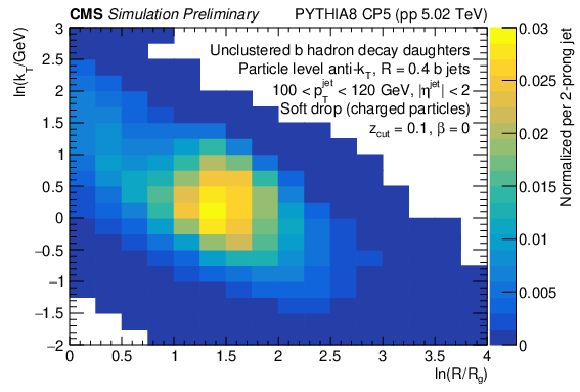
png pdf |
Figure 2-a:
The Lund jet plane of the soft drop emissions of b quark jets at the particle level simulation (PYTHIA8 CP5). The vertical axis is the logarithm of the kT of the emission, whereas the horizontal axis is the logarithm of R/Rg, such that large-angle emissions populate the left-hand side of the diagrams and small-angle emissions populate the right-hand side. Left panel: the Lund plane with the b hadron charged decay daughters present and treated at the same level as the other hadrons in the CA declustering, where the effect of the decays can be observed in the yellow hotspot at small angles and low kT. Right panel: with the b hadron charged decay daughters clustered together, i.e., the charged component of the b hadron remains intact. |
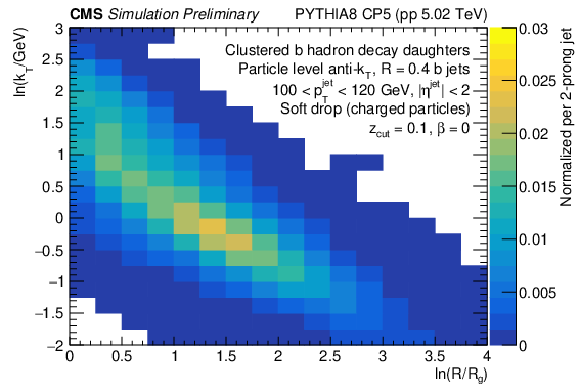
png pdf |
Figure 2-b:
The Lund jet plane of the soft drop emissions of b quark jets at the particle level simulation (PYTHIA8 CP5). The vertical axis is the logarithm of the kT of the emission, whereas the horizontal axis is the logarithm of R/Rg, such that large-angle emissions populate the left-hand side of the diagrams and small-angle emissions populate the right-hand side. Left panel: the Lund plane with the b hadron charged decay daughters present and treated at the same level as the other hadrons in the CA declustering, where the effect of the decays can be observed in the yellow hotspot at small angles and low kT. Right panel: with the b hadron charged decay daughters clustered together, i.e., the charged component of the b hadron remains intact. |

png pdf |
Figure 3:
The modification of the Rg (left) and zg (right) distributions at the detector level without (violet dotted curve) and with (orange dashed and dotted curve) the partial reconstruction of the b hadron, compared to the particle level distribution with the charged part of the generated b hadron intact (blue solid curve). The events are produced by the PYTHIA8 CP5 generator. |

png pdf |
Figure 3-a:
The modification of the Rg (left) and zg (right) distributions at the detector level without (violet dotted curve) and with (orange dashed and dotted curve) the partial reconstruction of the b hadron, compared to the particle level distribution with the charged part of the generated b hadron intact (blue solid curve). The events are produced by the PYTHIA8 CP5 generator. |

png pdf |
Figure 3-b:
The modification of the Rg (left) and zg (right) distributions at the detector level without (violet dotted curve) and with (orange dashed and dotted curve) the partial reconstruction of the b hadron, compared to the particle level distribution with the charged part of the generated b hadron intact (blue solid curve). The events are produced by the PYTHIA8 CP5 generator. |

png pdf |
Figure 4:
Examples of the fit of the partially reconstructed b hadron mass to double-b, single-b, and light+c jet templates coming from PYTHIA8 CP5. From left to right, the distributions in selected Rg, zg and zb,ch are presented. The black points represent the data counts, while the violet, blue, and orange filled curves represent the double-b, single-b, and light+c jet templates from the top to the bottom of the stacked histogram, with the fractions acquired from the fit. The ratio between the data and the fit values is also presented. |
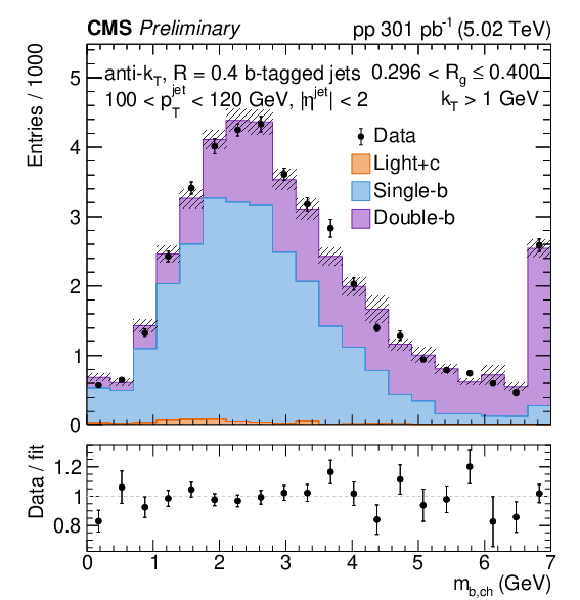
png pdf |
Figure 4-a:
Examples of the fit of the partially reconstructed b hadron mass to double-b, single-b, and light+c jet templates coming from PYTHIA8 CP5. From left to right, the distributions in selected Rg, zg and zb,ch are presented. The black points represent the data counts, while the violet, blue, and orange filled curves represent the double-b, single-b, and light+c jet templates from the top to the bottom of the stacked histogram, with the fractions acquired from the fit. The ratio between the data and the fit values is also presented. |

png pdf |
Figure 4-b:
Examples of the fit of the partially reconstructed b hadron mass to double-b, single-b, and light+c jet templates coming from PYTHIA8 CP5. From left to right, the distributions in selected Rg, zg and zb,ch are presented. The black points represent the data counts, while the violet, blue, and orange filled curves represent the double-b, single-b, and light+c jet templates from the top to the bottom of the stacked histogram, with the fractions acquired from the fit. The ratio between the data and the fit values is also presented. |

png pdf |
Figure 4-c:
Examples of the fit of the partially reconstructed b hadron mass to double-b, single-b, and light+c jet templates coming from PYTHIA8 CP5. From left to right, the distributions in selected Rg, zg and zb,ch are presented. The black points represent the data counts, while the violet, blue, and orange filled curves represent the double-b, single-b, and light+c jet templates from the top to the bottom of the stacked histogram, with the fractions acquired from the fit. The ratio between the data and the fit values is also presented. |

png pdf |
Figure 5:
The breakdown of systematic uncertainties for inclusive jets (upper panel: Rg, lower panel: zg). The statistical uncertainty is also shown in gray shaded boxes. |

png pdf |
Figure 5-a:
The breakdown of systematic uncertainties for inclusive jets (upper panel: Rg, lower panel: zg). The statistical uncertainty is also shown in gray shaded boxes. |

png pdf |
Figure 5-b:
The breakdown of systematic uncertainties for inclusive jets (upper panel: Rg, lower panel: zg). The statistical uncertainty is also shown in gray shaded boxes. |

png pdf |
Figure 6:
The breakdown of systematic uncertainties for b jets (Top panel: Rg, middle panel: zg, bottom panel: zb,ch). The statistical uncertainty is also shown in gray shaded boxes. |

png pdf |
Figure 6-a:
The breakdown of systematic uncertainties for b jets (Top panel: Rg, middle panel: zg, bottom panel: zb,ch). The statistical uncertainty is also shown in gray shaded boxes. |
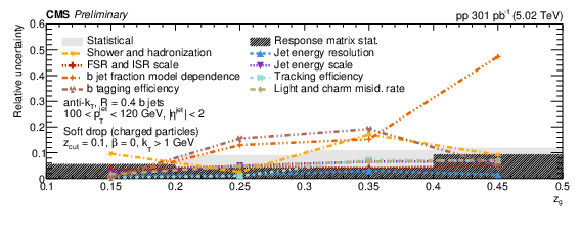
png pdf |
Figure 6-b:
The breakdown of systematic uncertainties for b jets (Top panel: Rg, middle panel: zg, bottom panel: zb,ch). The statistical uncertainty is also shown in gray shaded boxes. |

png pdf |
Figure 6-c:
The breakdown of systematic uncertainties for b jets (Top panel: Rg, middle panel: zg, bottom panel: zb,ch). The statistical uncertainty is also shown in gray shaded boxes. |
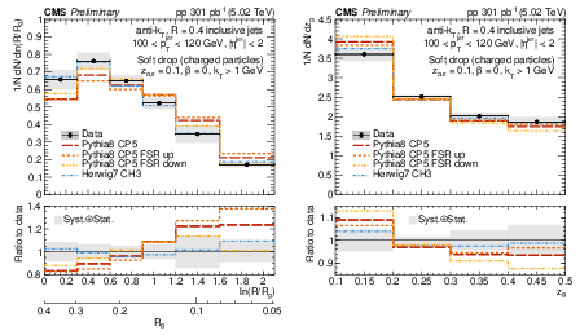
png pdf |
Figure 7:
Distributions of groomed substructure observables Rg (left) and zg (right) corrected to the stable-particle level for inclusive jets. The gray band represents the systematic uncertainties added in quadrature, while the vertical bars represent the statistical uncertainty. A comparison with PYTHIA8 CP5 and HERWIG 7 CH3 MC event generators is presented. |

png pdf |
Figure 7-a:
Distributions of groomed substructure observables Rg (left) and zg (right) corrected to the stable-particle level for inclusive jets. The gray band represents the systematic uncertainties added in quadrature, while the vertical bars represent the statistical uncertainty. A comparison with PYTHIA8 CP5 and HERWIG 7 CH3 MC event generators is presented. |

png pdf |
Figure 7-b:
Distributions of groomed substructure observables Rg (left) and zg (right) corrected to the stable-particle level for inclusive jets. The gray band represents the systematic uncertainties added in quadrature, while the vertical bars represent the statistical uncertainty. A comparison with PYTHIA8 CP5 and HERWIG 7 CH3 MC event generators is presented. |

png pdf |
Figure 8:
Distributions of the groomed substructure observables Rg (left) and zg (right) corrected to the particle level for b jets. A comparison with PYTHIA8 CP5 and HERWIG 7 CH3 MC event generators is presented. |

png pdf |
Figure 8-a:
Distributions of the groomed substructure observables Rg (left) and zg (right) corrected to the particle level for b jets. A comparison with PYTHIA8 CP5 and HERWIG 7 CH3 MC event generators is presented. |

png pdf |
Figure 8-b:
Distributions of the groomed substructure observables Rg (left) and zg (right) corrected to the particle level for b jets. A comparison with PYTHIA8 CP5 and HERWIG 7 CH3 MC event generators is presented. |

png pdf |
Figure 9:
The distribution of the charged momentum fraction zb,ch of the partially reconstructed b hadron corrected to the particle level. A comparison with PYTHIA8 CP5 and HERWIG 7 CH3 MC event generators is presented. |

png pdf |
Figure 10:
A comparison of the groomed observables Rg (left) and zg (right) between b and inclusive jets. Most sources of systematic uncertainty are considered fully correlated in the ratio, with the exception of those related to flavor. |

png pdf |
Figure 10-a:
A comparison of the groomed observables Rg (left) and zg (right) between b and inclusive jets. Most sources of systematic uncertainty are considered fully correlated in the ratio, with the exception of those related to flavor. |
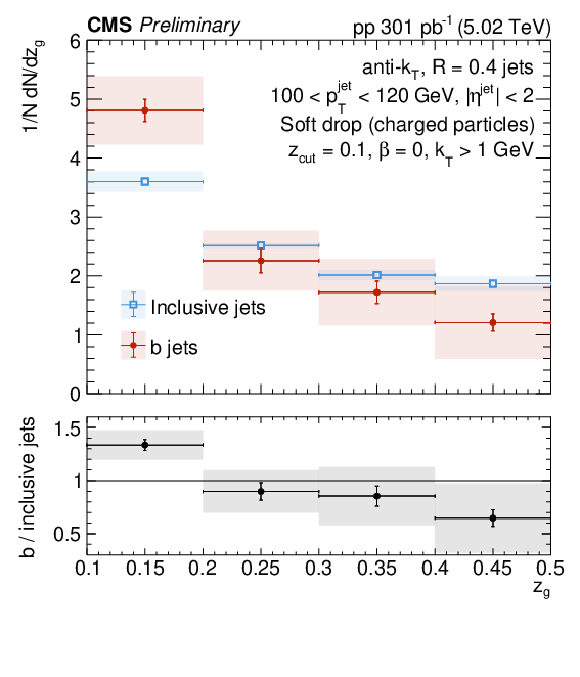
png pdf |
Figure 10-b:
A comparison of the groomed observables Rg (left) and zg (right) between b and inclusive jets. Most sources of systematic uncertainty are considered fully correlated in the ratio, with the exception of those related to flavor. |
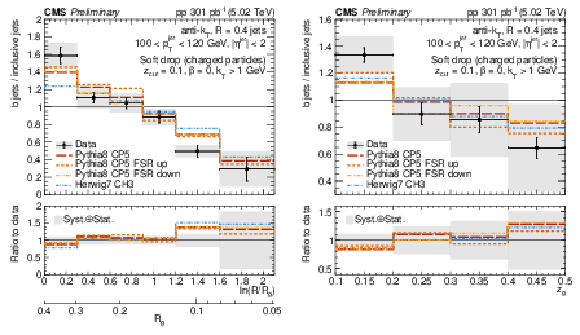
png pdf |
Figure 11:
The ratio of the groomed observables Rg (left) and zg (right) between b and inclusive jets compared to the PYTHIA8 CP5 and HERWIG 7 CH3 MC event generators. Most sources of systematic uncertainty are considered fully correlated in the ratio, with the exception of those related to flavor. |
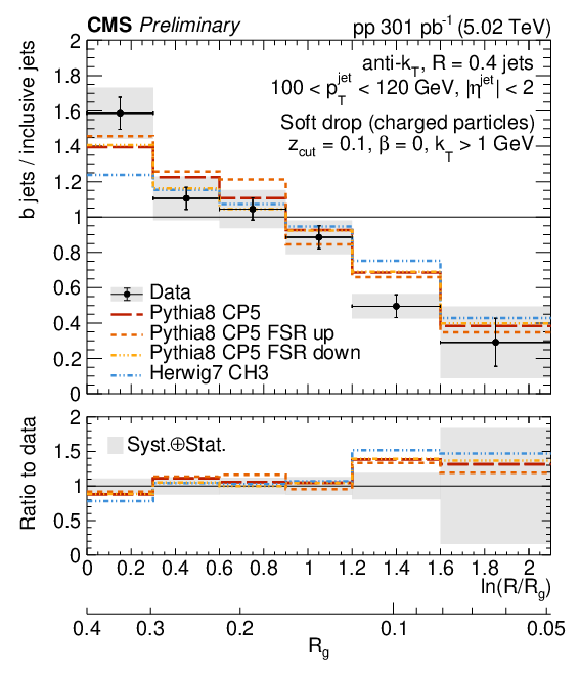
png pdf |
Figure 11-a:
The ratio of the groomed observables Rg (left) and zg (right) between b and inclusive jets compared to the PYTHIA8 CP5 and HERWIG 7 CH3 MC event generators. Most sources of systematic uncertainty are considered fully correlated in the ratio, with the exception of those related to flavor. |

png pdf |
Figure 11-b:
The ratio of the groomed observables Rg (left) and zg (right) between b and inclusive jets compared to the PYTHIA8 CP5 and HERWIG 7 CH3 MC event generators. Most sources of systematic uncertainty are considered fully correlated in the ratio, with the exception of those related to flavor. |
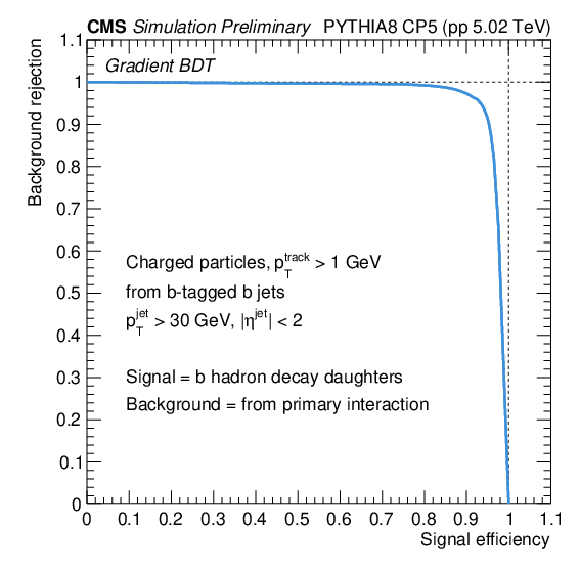
png pdf |
Figure 12:
The background rejection rate versus the signal efficiency for the b hadron decay product identification. The model is a gradient boosted decision tree with 11 input variables related to tracking and secondary vertex information. ``Background'' refers to charged particles coming from the primary interaction, while ``signal'' signifies charged particles resulting from a b hadron decay. Dashed lines are drawn at 1 for each axis. The intersection of those lines is the optimal performance of a classifier. |
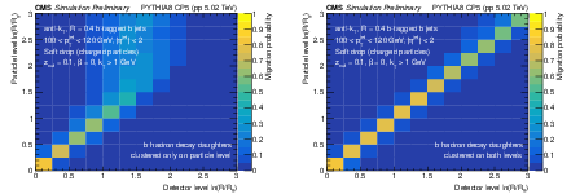
png pdf |
Figure 13:
The migration matrices of Rg for b jets. The particle level corresponds to clustered b hadron decay products. In the left panel, the decay products are present during the iterative declustering at the detector level, while in the right panel, the decay products have been identified using the gradient boosted decision tree and they have been clustered together into the partially reconstructed b hadron and replaced in the jet constituents. |

png pdf |
Figure 13-a:
The migration matrices of Rg for b jets. The particle level corresponds to clustered b hadron decay products. In the left panel, the decay products are present during the iterative declustering at the detector level, while in the right panel, the decay products have been identified using the gradient boosted decision tree and they have been clustered together into the partially reconstructed b hadron and replaced in the jet constituents. |
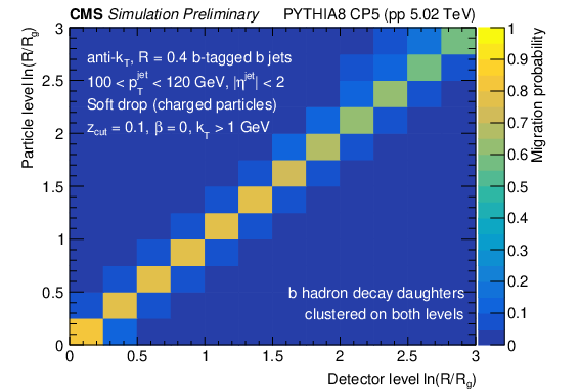
png pdf |
Figure 13-b:
The migration matrices of Rg for b jets. The particle level corresponds to clustered b hadron decay products. In the left panel, the decay products are present during the iterative declustering at the detector level, while in the right panel, the decay products have been identified using the gradient boosted decision tree and they have been clustered together into the partially reconstructed b hadron and replaced in the jet constituents. |
| Summary |
| This note presented a measurement of the substructure of bottom quark jets (b jets) and of inclusive jets in proton-proton (pp) collisions at √s= 5.02 TeV using data corresponding to an integrated luminosity of 301 pb−1 collected in 2017 with the CMS experiment. We analyzed the substructure of jets initially clustered with the anti-kT algorithm with the distance parameter R= 0.4 having transverse momentum 100 <pT< 120 GeV and pseudorapidity |η|< 2. The charged-particle constituents of the jets are used for the substructure. The groomed jet radius Rg, groomed momentum fraction zg, and the jet fragmentation function zb,ch are measured and corrected to the particle level. Such corrections include background subtraction, migration effects and efficiency corrections. A challenge in the interpretation of previous b jet substructure measurements is that the b hadron decay daughters are clustered in the jet at an equal footing as the hadrons that are produced from the transition from partons to hadrons. To better understand the gluon-radiation pattern from b jets, the b hadron decay daughters need to be handled in a careful way experimentally. This measurement uses an algorithm to identify and cluster the b hadron decay charged-particle daughters of b-tagged jets in a generic way, which allows for a cleaner interpretation of the measured substructure distributions in terms of the parton showering description. The contributions from gluon, light quark, charm quark jets, and gluon splitting (g→bˉb) are subtracted from the measured distributions. The distributions are unfolded to the charged particle level using unregularized unfolding. The correction to the charged particle level accounts also for the removal of the particle-level biases that arise from the usage of b tagging at the detector-level, which is applied as a bin-by-bin substructure- and jet pT-dependent correction after the unfolding correction for bin-to-bin migration effects. The particle-level distributions have uncertainties of the order of 5% and up to 20%, dominated by the physics model uncertainty in most of the bins ( HERWIG 7 CH3 compared with PYTHIA8 CP5). The groomed-jet radius and groomed momentum fraction of b jets is well described by PYTHIA8 CP5 and HERWIG 7 CH3 simulations. The jet fragmentation function, on the other hand, is described better by PYTHIA8 CP5 at high values of z≈ 1 (i.e., for cases where the b hadron carries a substantial amount of the jet pT). The z≈ 1 region corresponds to b jets without splittings that satisfy the soft drop condition. Therefore, zg, Rg, and zb,ch can be used simultaneously to constrain nonperturbative and perturbative aspects of b jet substructure. When comparing to inclusive jets, we find large differences, not covered by the systematic uncertainties, for Rg. The suppression at small Rg for b jets is consistent with the expectations of the dead cone effect. The b jets also have a more asymmetric groomed momentum balance zg than the inclusive jet reference, indicating that the b quark carries a greater amount of momentum when emitting gluons. The measurement shows that the distributions that remove soft- and wide-angle radiation are well described by the PYTHIA8 CP5 and HERWIG 7 CH3 event generators for b jets. For the jet fragmentation function, PYTHIA8 CP5 describes the data better than HERWIG 7 CH3. Although both HERWIG 7 CH3 and PYTHIA8 CP5 describe the Rg and zg distributions well for b jets, PYTHIA8 CP5 does not have a good description of the inclusive jet substructure. |
| References | ||||
| 1 | A. J. Larkoski, I. Moult, and B. Nachman | Jet substructure at the Large Hadron Collider: a review of recent advances in theory and machine learning | Phys. Rept. 841 (2020) 1 | 1709.04464 |
| 2 | S. Marzani, G. Soyez, and M. Spannowsky | Looking inside jets: an introduction to jet substructure and boosted-object phenomenology | Lect. Notes Phys. 958 (2019) 1 | 1901.10342 |
| 3 | R. Kogler | Advances in jet substructure at the LHC: Algorithms, measurements and searches for new physical phenomena | volume 284 of Springer Tracts Mod. Phys. Springer, ISBN~978-3-030-72857-1, 978-3-030-72858-8, 2021 link |
|
| 4 | V. N. Gribov and L. N. Lipatov | Deep inelastic electron-proton scattering in perturbation theory | Sov. J. Nucl. Phys. 15 (1972) 438 | |
| 5 | Y. L. Dokshitzer | Calculation of the structure functions for deep inelastic scattering and e+ e- Annihilation by Perturbation Theory in Quantum Chromodynamics. | Sov. Phys. JETP 46 (1977) 641 | |
| 6 | G. Altarelli and G. Parisi | Asymptotic freedom in parton language | NPB 126 (1977) 298 | |
| 7 | Y. L. Dokshitzer, V. A. Khoze, and S. I. Troian | On specific QCD properties of heavy quark fragmentation ('dead cone') | JPG 17 (1991) 1602 | |
| 8 | ALICE Collaboration | Direct observation of the dead cone effect in quantum chromodynamics | Nature 605 (2022) 440 | 2106.05713 |
| 9 | CMS Collaboration | Identification of heavy-flavor jets with the CMS detector in pp collisions at 13 TeV | JINST 13 (2018) P05011 | CMS-BTV-16-002 1712.07158 |
| 10 | Kogler, Roman and others | Jet substructure at the Large Hadron Collider: experimental review | Rev. Mod. Phys. 91 (2019) 045003 | 1803.06991 |
| 11 | CMS Collaboration | Evidence of b-Jet Quenching in PbPb Collisions at √sNN= 2.76 TeV | PRL 113 (2014) 132301 | CMS-HIN-12-003 1312.4198 |
| 12 | ATLAS Collaboration | Measurement of the nuclear modification factor of b-jets in 5.02 TeV Pb+Pb collisions with the ATLAS detector | EPJC 83 (2023) 438 | 2204.13530 |
| 13 | CMS Collaboration | Comparing transverse momentum balance of b jet pairs in pp and PbPb collisions at √sNN= 5.02 TeV | JHEP 03 (2018) 181 | CMS-HIN-16-005 1802.00707 |
| 14 | L. Cunqueiro and M. Płoskoń | Searching for the dead cone effects with iterative declustering of heavy-flavor jets | PRD 99 (2019) 074027 | 1812.00102 |
| 15 | L. Cunqueiro, D. Napoletano, and A. Soto-Ontoso | Dead-cone searches in heavy-ion collisions using the jet tree | PRD 107 (2023) 094008 | 2211.11789 |
| 16 | C. Lee, P. Shrivastava, and V. Vaidya | Predictions for energy correlators probing substructure of groomed heavy-quark jets | JHEP 09 (2019) 045 | 1901.09095 |
| 17 | S. Kluth, W. Ochs, and R. Perez Ramos | Observation of the dead cone effect in charm and bottom quark jets and its QCD explanation | PRD 107 (2023) 094039 | 2303.13343 |
| 18 | A. J. Larkoski, S. Marzani, G. Soyez, and J. Thaler | Soft drop | JHEP 05 (2014) 146 | 1402.2657 |
| 19 | M. Dasgupta, A. Fregoso, S. Marzani, and G. P. Salam | Towards an understanding of jet substructure | JHEP 09 (2013) 029 | 1307.0007 |
| 20 | Y. L. Dokshitzer, G. D. Leder, S. Moretti, and B. R. Webber | Better jet clustering algorithms | JHEP 08 (1997) 001 | hep-ph/9707323 |
| 21 | S. Caletti, A. Ghira, and S. Marzani | On heavy-flavor jets with soft drop | EPJC 84 (2024) 212 | 2312.11623 |
| 22 | DELPHI Collaboration | A study of the b-quark fragmentation function with the DELPHI detector at LEP I and an averaged distribution obtained at the Z Pole | EPJC 71 (2011) 1557 | 1102.4748 |
| 23 | OPAL Collaboration | Inclusive analysis of the b quark fragmentation function in Z decays at LEP | EPJC 29 (2003) 463 | hep-ex/0210031 |
| 24 | ALEPH Collaboration | Study of the fragmentation of b quarks into B mesons at the Z peak | PLB 512 (2001) 30 | hep-ex/0106051 |
| 25 | CMS Collaboration | The CMS Experiment at the CERN LHC | JINST 3 (2008) S08004 | |
| 26 | CMS Collaboration | Technical proposal for the Phase-2 upgrade of the Compact Muon Solenoid | CMS Technical Proposal CERN-LHCC-2015-010, CMS-TDR-15-02, 2015 CDS |
|
| 27 | CMS Collaboration | Particle-flow reconstruction and global event description with the CMS detector | JINST 12 (2017) P10003 | CMS-PRF-14-001 1706.04965 |
| 28 | M. Cacciari, G. P. Salam, and G. Soyez | The anti-kT jet clustering algorithm | JHEP 04 (2008) 063 | 0802.1189 |
| 29 | M. Cacciari, G. P. Salam, and G. Soyez | FastJet user manual | EPJC 72 (2012) 1896 | 1111.6097 |
| 30 | CMS Collaboration | Pileup mitigation at CMS in 13 TeV data | JINST 15 (2020) P09018 | CMS-JME-18-001 2003.00503 |
| 31 | CMS Collaboration | Jet energy scale and resolution in the CMS experiment in pp collisions at 8 TeV | JINST 12 (2017) P02014 | CMS-JME-13-004 1607.03663 |
| 32 | H. Qu and L. Gouskos | Jet tagging via particle clouds | PRD 101 (2020) 056019 | 1902.08570 |
| 33 | CMS Tracker Group | The CMS Phase-1 pixel detector upgrade | JINST 16 (2021) P02027 | 2012.14304 |
| 34 | CMS Collaboration | Performance of the CMS Level-1 trigger in proton-proton collisions at √s= 13 TeV | JINST 15 (2020) P10017 | CMS-TRG-17-001 2006.10165 |
| 35 | CMS Collaboration | The CMS trigger system | JINST 12 (2017) P01020 | CMS-TRG-12-001 1609.02366 |
| 36 | CMS Collaboration | Luminosity measurement in proton-proton collisions at 5.02 TeV in 2017 at CMS | CMS Physics Analysis Summary, 2021 CMS-PAS-LUM-19-001 |
CMS-PAS-LUM-19-001 |
| 37 | GEANT4 Collaboration | GEANT 4--a simulation toolkit | NIM A 506 (2003) 250 | |
| 38 | F. A. Dreyer, G. P. Salam, and G. Soyez | The Lund jet plane | JHEP 12 (2018) 064 | 1807.04758 |
| 39 | ALICE Collaboration | Measurement of the groomed jet radius and momentum splitting fraction in pp and Pb-Pb collisions at √sNN= 5.02 TeV | PRL 128 (2022) 102001 | 2107.12984 |
| 40 | ATLAS Collaboration | Measurement of soft-drop jet observables in pp collisions with the ATLAS detector at √s= 13 TeV | PRD 101 (2020) 052007 | 1912.09837 |
| 41 | CMS Collaboration | Study of quark and gluon jet substructure in Z+jet and dijet events from pp collisions | JHEP 01 (2022) 188 | CMS-SMP-20-010 2109.03340 |
| 42 | CMS Collaboration | Measurements of the differential jet cross section as a function of the jet mass in dijet events from proton-proton collisions at √s= 13 TeV | JHEP 11 (2018) 113 | CMS-SMP-16-010 1807.05974 |
| 43 | ATLAS Collaboration | Measurement of jet substructure observables in top quark, W boson and light jet production in proton-proton collisions at √s= 13 TeV with the ATLAS detector | JHEP 08 (2019) 033 | 1903.02942 |
| 44 | ATLAS Collaboration | Measurements of Lund subjet multiplicities in 13 TeV proton-proton collisions with the ATLAS detector | Submitted to Phys. Lett. B, 2024 | 2402.13052 |
| 45 | ATLAS Collaboration | Measurement of the Lund jet plane using charged particles in 13 TeV proton-proton collisions with the ATLAS detector | PRL 124 (2020) 222002 | 2004.03540 |
| 46 | CMS Collaboration | Measurement of the primary Lund jet plane density in proton-proton collisions at √s = 13 TeV | JHEP 05 (2024) 116 | CMS-SMP-22-007 2312.16343 |
| 47 | ATLAS Collaboration | Measurement of the Lund jet plane in hadronic decays of top quarks and W bosons with the ATLAS detector | Submitted to Eur. Phys. J. C, 2024 | 2407.10879 |
| 48 | ALICE Collaboration | Measurements of groomed-jet substructure of charm jets tagged by D0 mesons in proton-proton collisions at √s= 13 TeV | PRL 131 (2023) 192301 | 2208.04857 |
| 49 | Particle Data Group Collaboration | Review of particle physics | Prog. Theor. Exp. Phys. 2022 (2022) 083C01 | |
| 50 | CMS Collaboration | Measurement of jet substructure observables in t¯t events from proton-proton collisions at √s= 13TeV | PRD 98 (2018) 092014 | CMS-TOP-17-013 1808.07340 |
| 51 | CMS Collaboration | Measurement of b jet shapes in proton-proton collisions at √s= 5.02 TeV | JHEP 05 (2021) 054 | CMS-HIN-18-020 2005.14219 |
| 52 | ATLAS Collaboration | Measurement of b-quark fragmentation properties in jets using the decay B±→J/ψK± in pp collisions at √s = 13 TeV with the ATLAS detector | JHEP 12 (2021) 131 | 2108.11650 |
| 53 | LHCb Collaboration | Study of J/ψ Production in Jets | PRL 118 (2017) 192001 | 1701.05116 |
| 54 | ATLAS Collaboration | Measurements of jet observables sensitive to b-quark fragmentation in t¯t events at the LHC with the ATLAS detector | PRD 106 (2022) 032008 | 2202.13901 |
| 55 | CMS Collaboration | Identification of b-Quark Jets with the CMS Experiment | JINST 8 (2013) P04013 | CMS-BTV-12-001 1211.4462 |
| 56 | L. Brenner et al. | Comparison of unfolding methods using RooFitUnfold | Int. J. Mod. Phys. A 35 (2020) 2050145 | 1910.14654 |
| 57 | M. Cacciari et al. | The t¯t cross section at 1.8 TeV and 1.96 TeV: a study of the systematics due to parton densities and scale dependence | JHEP 04 (2004) 068 | hep-ph/0303085 |
| 58 | S. Catani, D. de Florian, M. Grazzini, and P. Nason | Soft-gluon resummation for Higgs boson production at hadron colliders | JHEP 07 (2003) 028 | hep-ph/0306211 |

|
Compact Muon Solenoid LHC, CERN |

|

|

|

|

|

|